DIY reupholstered ottoman

Lately I’ve been coveting a coffee-table ottoman. You know: one of those oversized ottomans that you can kick your feet on from nearly any seat on the couch and use as a coffee table by merely adding a tray. I loved Pottery Barn’s striped Alexandria Ottoman (see below), but $700 was out of my price range. (This post contains affiliate links. If you use these links to buy something, I may earn a small commission. You can read my full disclosure here.)
Then I found the yellow floral ottoman (below) on Craigslist, and bought it for $60. The only thing it had going for it is its size and sturdy frame, so I gave it a makeover. I had never attempted reupholstering anything before, so with a little trepidation, I forged ahead.

After several weeks and copious amounts of stray threads strewn about my apartment, the ottoman was finished. People asked me if it was worth all the work. The answer is yes. The total cost (including the price of the original ottoman) was only $137.
And now, five years later, I concede that white fabric is impractical — even for a single gal with no kids or pets. So this footstool needs to be recovered again. Next time, I’m thinking slipcover.
Above: Pottery Barn Alexandria ottoman (no longer available).
My first DIY projects appeared in Sunset magazine’s now defunct blog, Home By Sunset. This post is an updated version of “Making the perfect ottoman, part 1-5,” originally published May–June 2007.
How to reupholster an ottoman
SUPPLIES
TOOLS
INSTRUCTIONS

1. Replace casters with bun feet. My footstool was too low to the ground, so the first thing I did was remove the casters. The casters were attached to pins that were set in plastic holders. I wedged a screwdriver under each wheel and hammered the handle end until the wheel popped out. My casters were two inches tall. To make the ottoman three inches taller (and level with my couch seat height), I needed 5-inch-tall feet.
2. Remove and discard the dust cover. Using a flathead screwdriver and pliers (or staple remover), remove the staples holding the dust cover on the bottom of the ottoman. (Specific upholstery tools are available, but a screwdriver and pliers work fine.) With the dust cover off, you can get a pretty good idea of how a piece of furniture is put together.

3. Attach the mounting plates. Drill pilot holes for each furniture-leg mounting plate (all five holes), then attach the screws using a screwdriver bit.

4. Screw in each bun foot. Screw the foot’s hanger bolt into the center hole of the mounting plate. Check that they are mounted correctly, then remove the feet to complete the rest of the steps below.
5. Decide on your fabric. Choose a durable heavyweight fabric or leather. I wanted to reupholster mine in white twill to match my Ikea Ektorp sofa, but I couldn’t find matching fabric. Then I found a white sofa slipcover in the as-is department at Ikea for $10. I laundered it, cut off its seams, and saved the big pieces.

6. Take apart the existing cover. Remove the staples holding the existing fabric to the frame. On my ottoman, the foam and batting were inside their own case, which made reassembling easier. Take apart the outer cover with a seam ripper. You’ll use these pieces as a pattern for your new cover. Save and reuse the piping as well.

7. Cut the fabric pieces using the old pieces as a pattern. Iron the old pieces and new fabric, then pin them together and cut out your new pieces the same size as the old.
8. Make the welting (piping). Cut your own bias tape from your fabric. I cut my strips the same width as the old strips of fabric (about 2 inches wide). Encase the original piping from the ottoman in the bias tape and baste it together lengthwise, stopping about two inches from each end of the piping. Cut your bias tape about two inches longer on one side than you think you need. You will tuck that under and sew it later.

9. Assemble the sides of the cushion. Sew the four sides of the cushion end-to-end, to make one long loop. Leave a half-inch seam allowance on all seams. Then pin and sew the welting around the top and bottom edges of the loop.
Tip: Fold each piece that you’ll be sewing together in half and mark with a fabric marker. Fold in half again and mark. You will then have four marks on each piece to match up and pin in place. Then pin halfway between those marks and so on, until you have a pin every few inches.

10. Attach the top of the cushion. Mark, pin, and sew the top piece to the side pieces. Sewing the corners is difficult with all those layers, but be patient and persistent.
Tip: Use your zipper foot when sewing welting, and move the needle to the far left — it allows you to sew closer to the piping.

11. Sew on the bottom of the cushion. If your ottoman is like mine, you can reuse the original bottom zippered piece of fabric. Sew it to the bottom edge of the cushion sides. Reusing this piece saves time and money, and it will be hidden anyway.
12. Sew the bottom pieces. Sew the bottom sides (that will cover the wooden frame) and welting using the same process as Step 9, except this time cut the welting strips twice as wide so you have extra fabric to wrap around the bottom of the ottoman. Sew the assembled ottoman sides (with the welting at the bottom) onto the bottom edge of your cushion cover.

13. Stuff the cushion. Unzip the zipper and stuff the cushion into the cover while trying to minimize wrinkling of the inner cover—which is harder than it looks.

14. Tufting. Measure and mark with straight pins where you want each covered button placed. Then, following the package instructions, make eight covered buttons (using circles cut from leftover fabric scraps).
Thread a 10-inch upholstery needle with a 2-foot-long piece of waxed button thread and push it through the cushion from the top down. Then, unthread the needle at the bottom, loop a button onto the piece that is still sticking out the top, and thread the needle again at the top. Push the needle through about ¼ inch from your first entry point, so both ends of the thread emerge from the bottom of the cushion. After repeating this on all eight buttons, place the cushion face down on the floor. Stand on the cushion (which compresses it), straddling each pair of threads. Pull the threads tight, tie them in a knot, and trim the excess thread.

15. Attach the cover to the frame. Once the cushion is zipped inside the cover, flip the whole cover over and slip it over the frame. Straighten and pull the edges tight. Flip the ottoman upside down. Fold the fabric over the bottom edge of the frame and staple it every few inches. Trim the excess fabric.
Tip: If any of the staples stick up a bit, hammer them down with a hammer.

16. Attach the dust cover. I used Pellon as the dust cover because it’s the closest fabric I could find to match the texture of the original. I don’t recommend it because it tears easily. I found dust cover fabric later. Cut the dust cover about 4 inches bigger than the ottoman. Fold the edges under about 2 inches and staple it to the frame. Then, cut holes where the hanger bolts screw in, and screw on the bun feet.

17. Finished. Flip the ottoman right side up. If you also choose a light-colored fabric, I suggest protecting it with Scotchguard before using your footstool.

Share this story
Reader Gallery
Made this project? Email your photo(s) to monica (at) craftynest (dot) com, and I’ll share your version here!



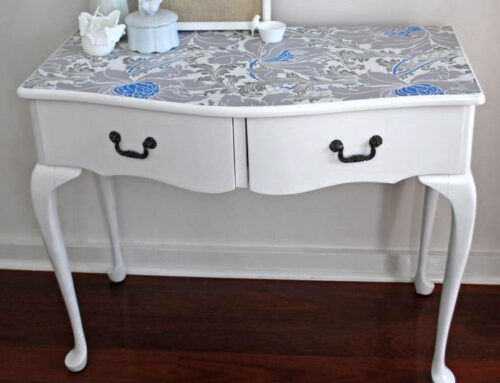
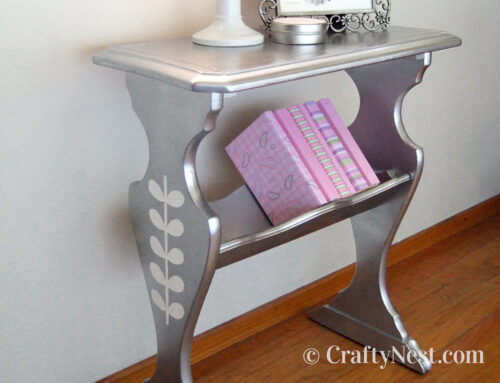
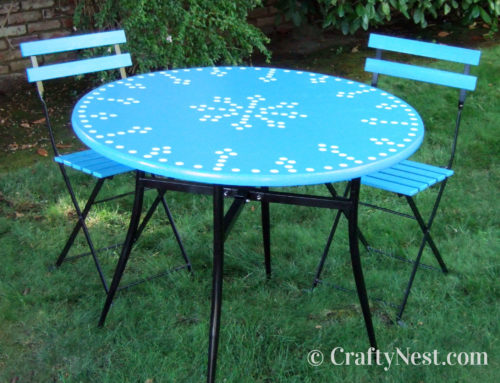
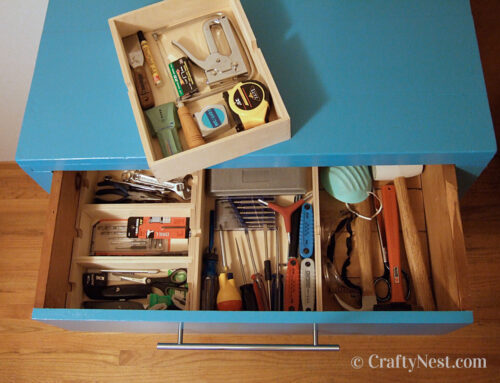
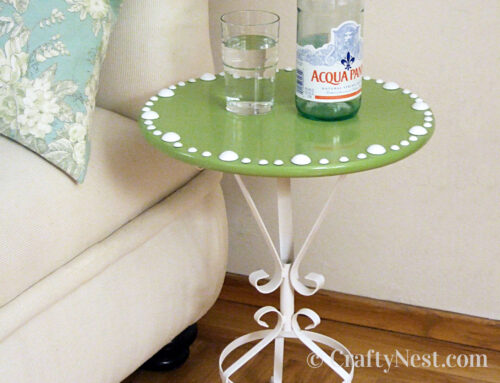
Best ottoman tutorial I found in the exact style I was looking for! Thank you!